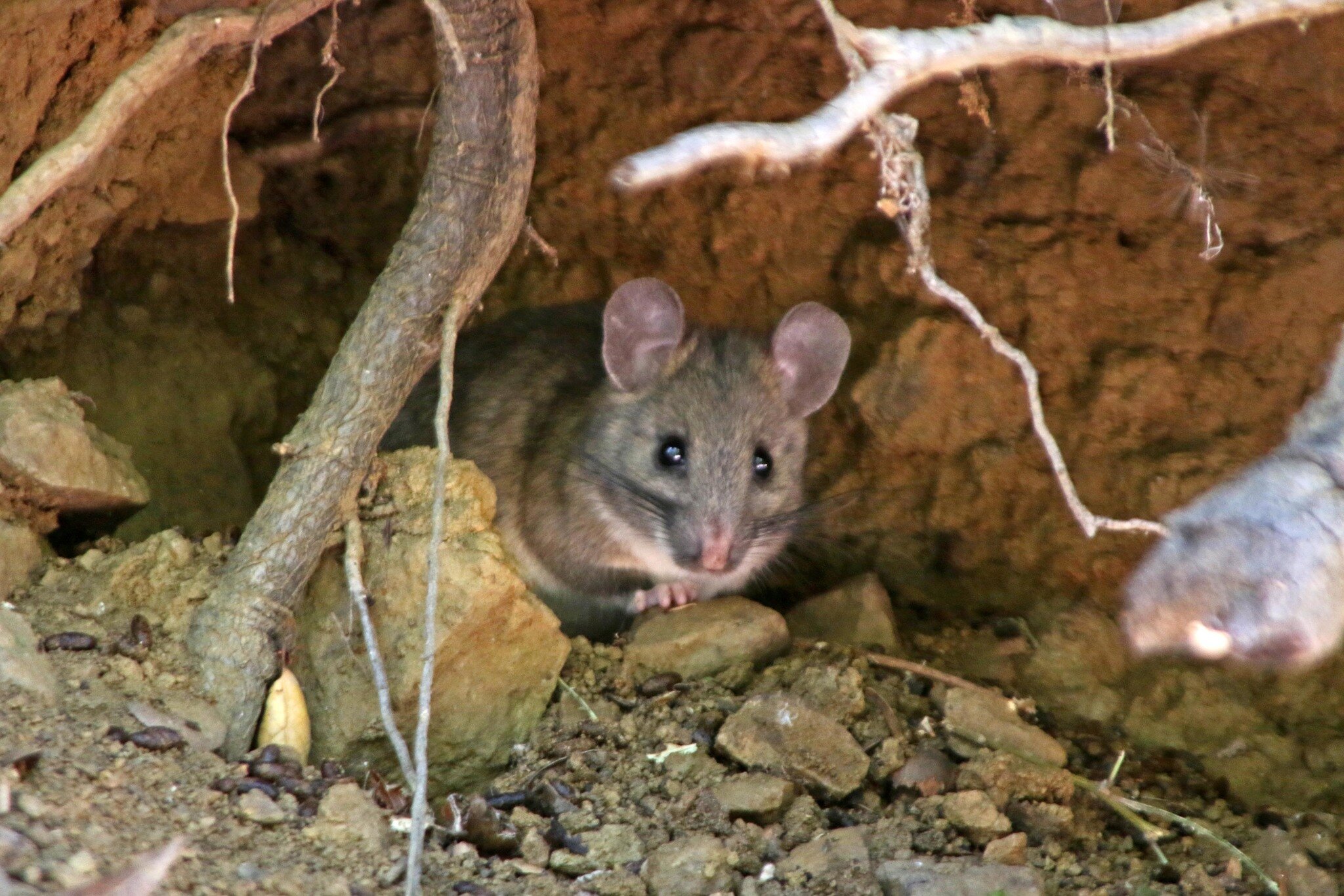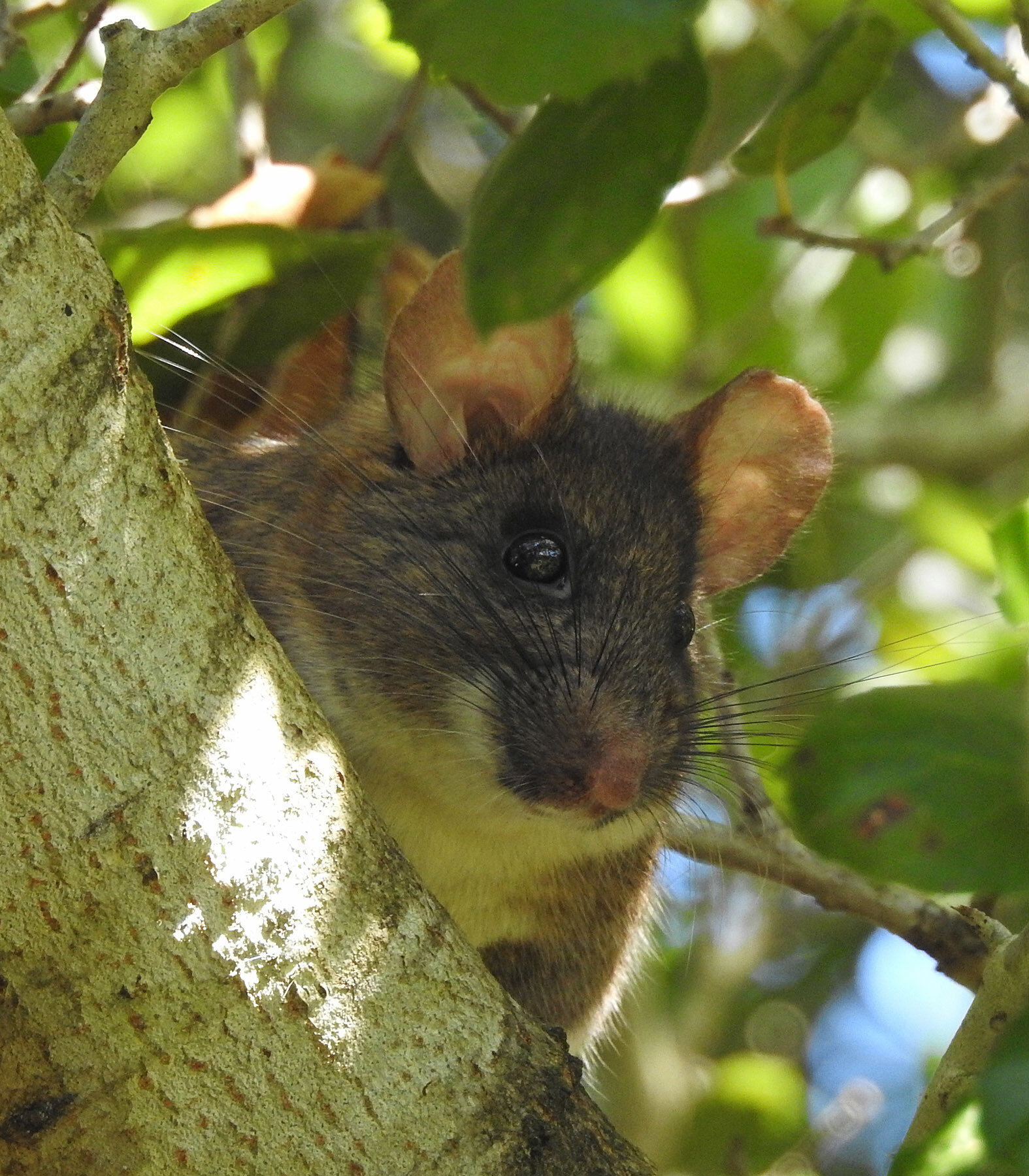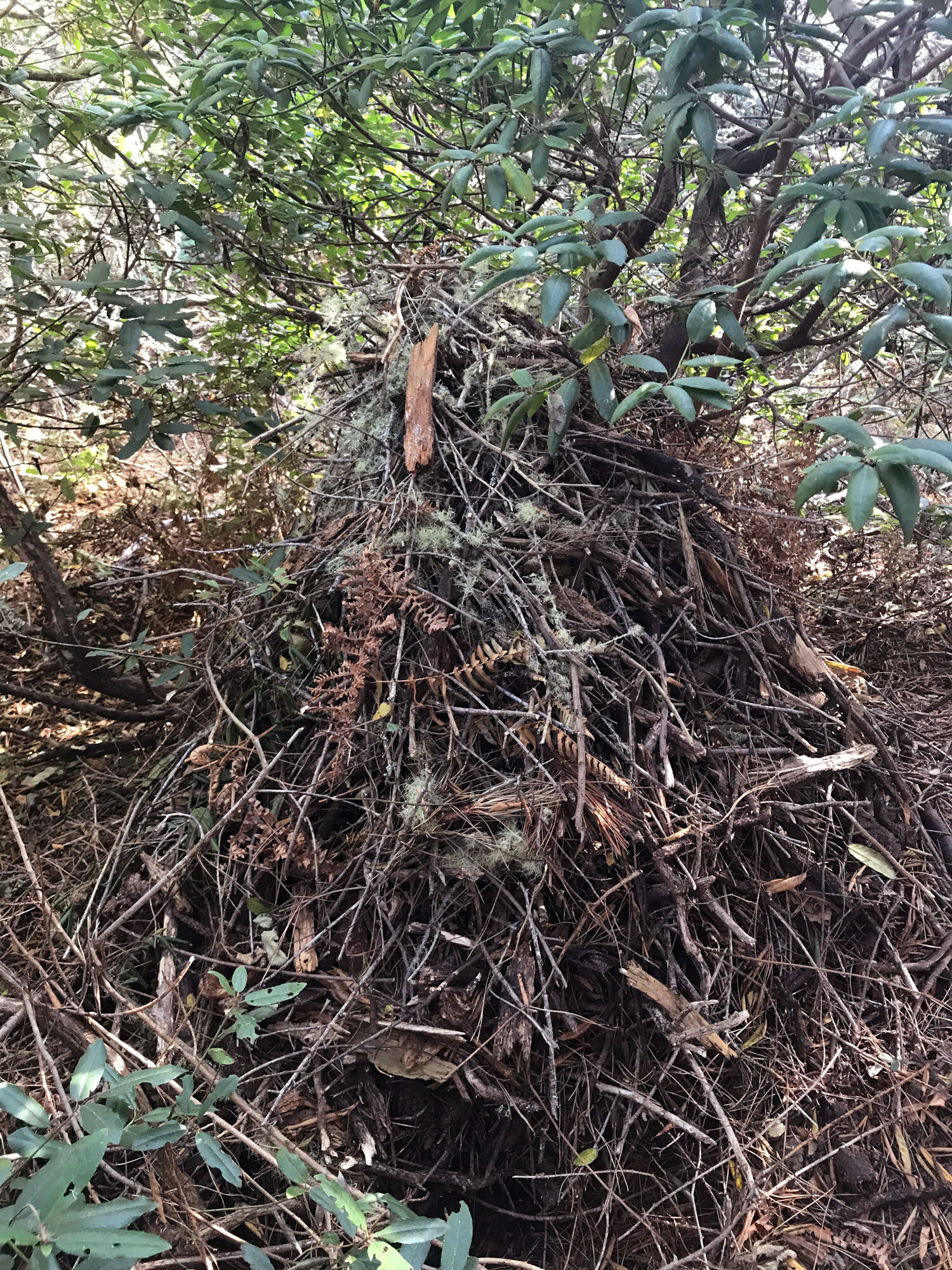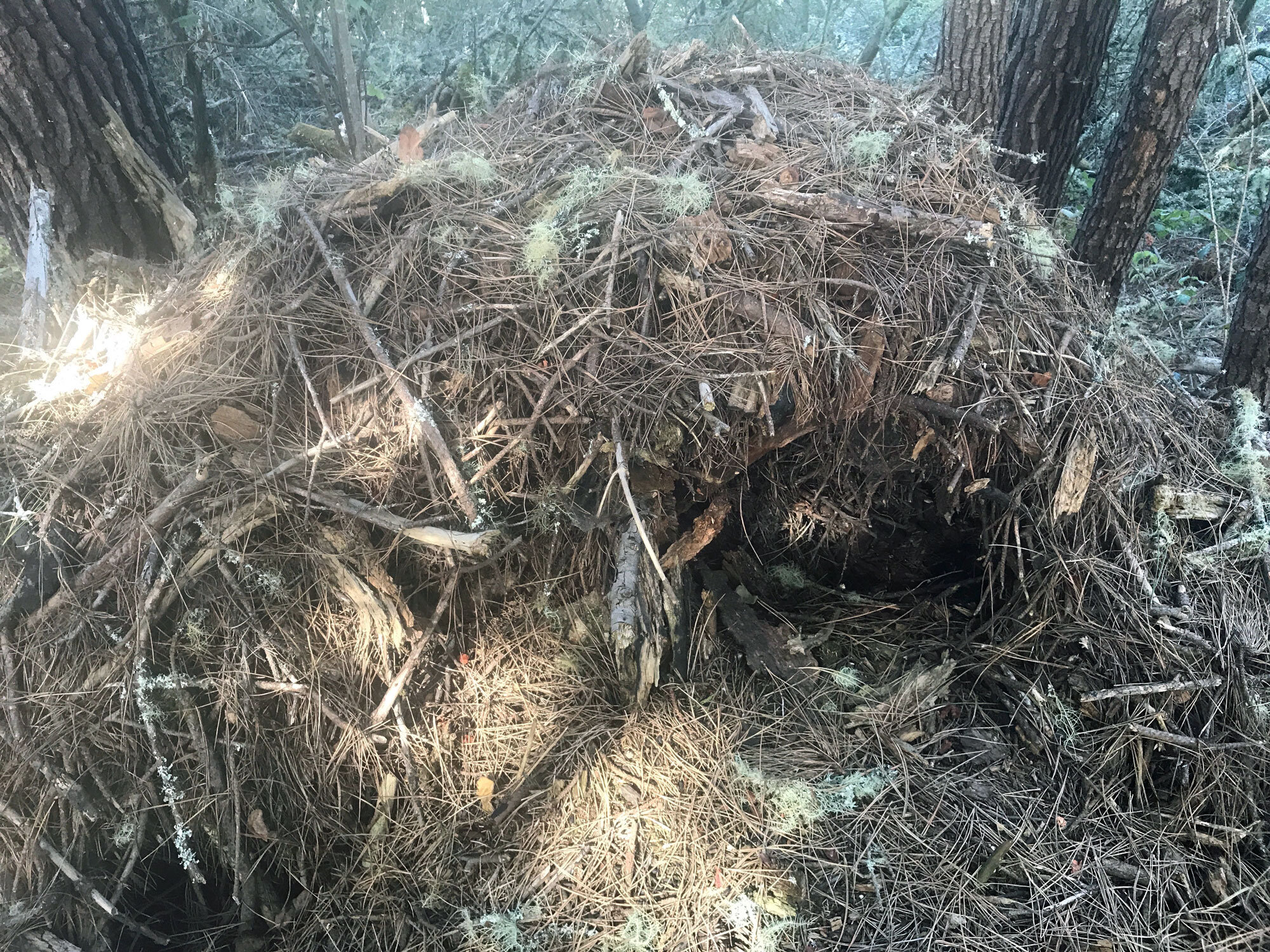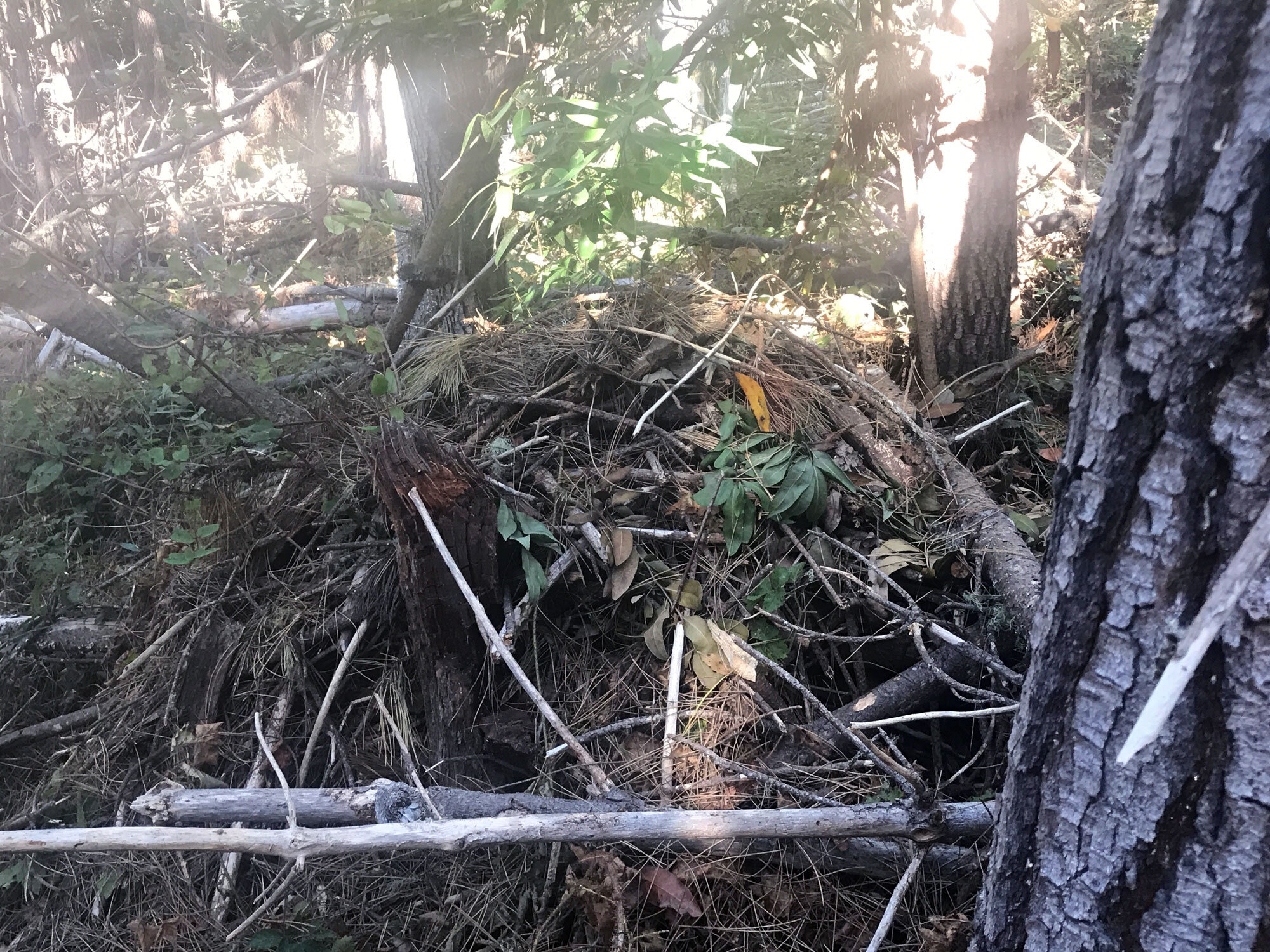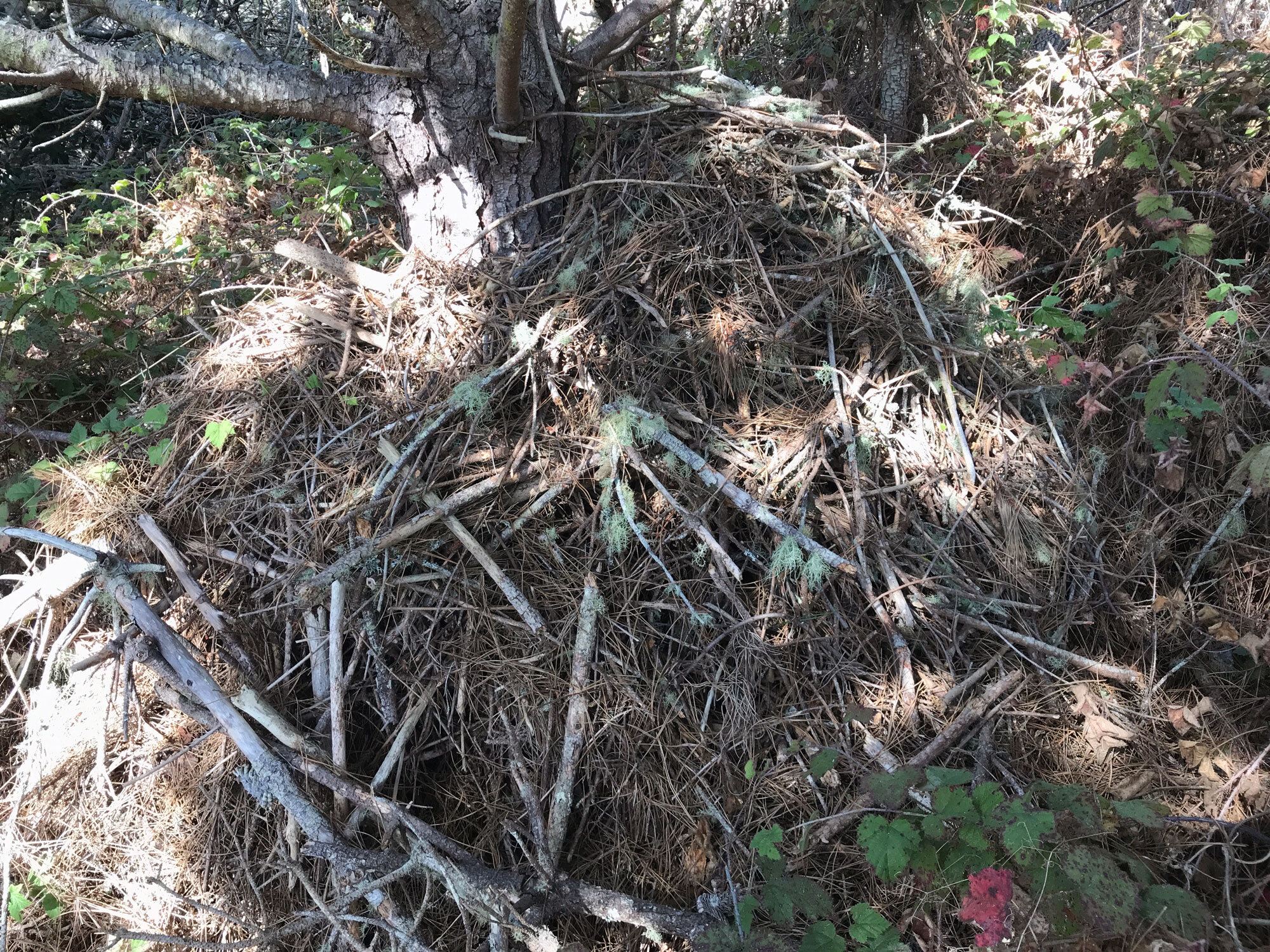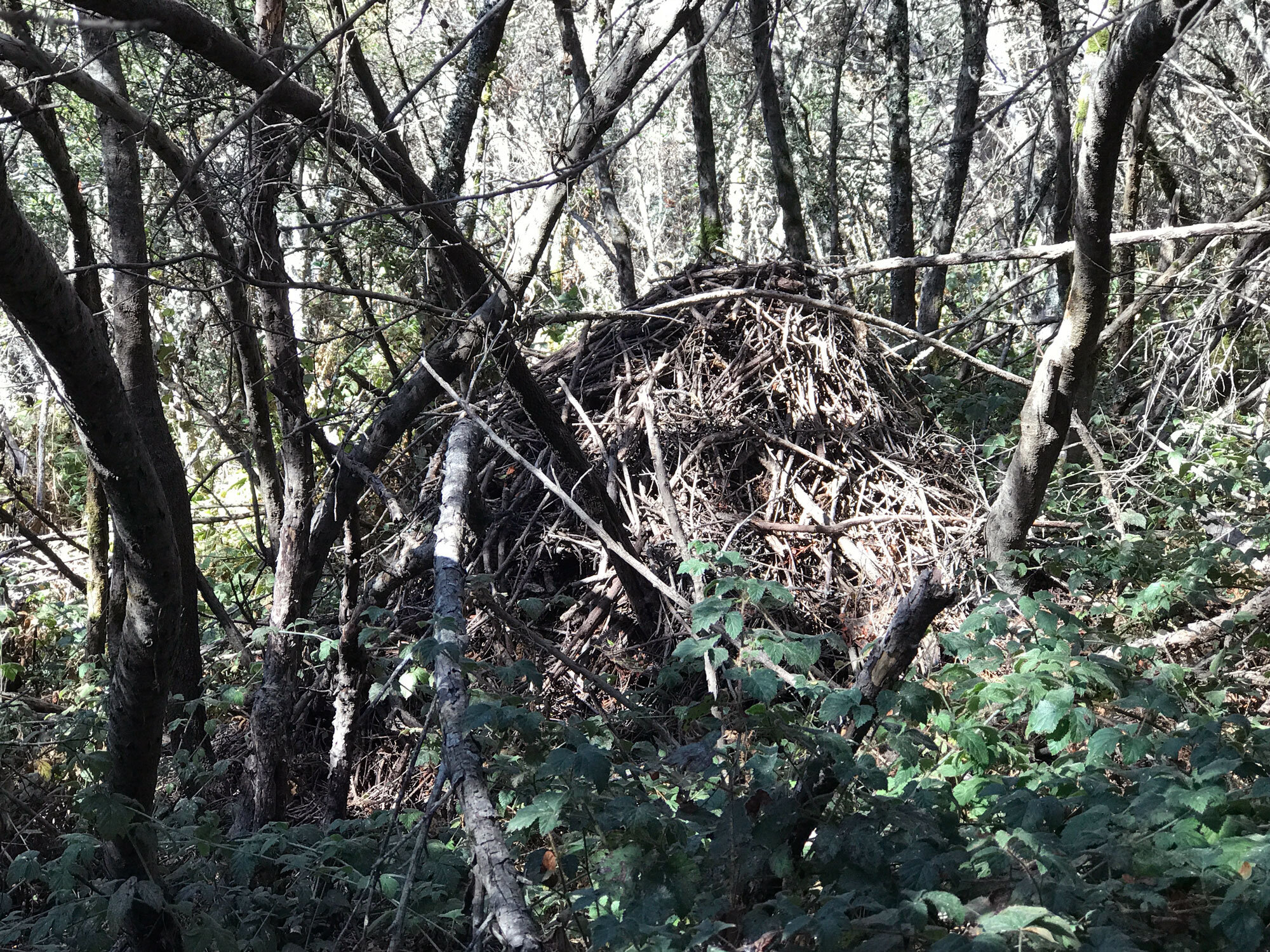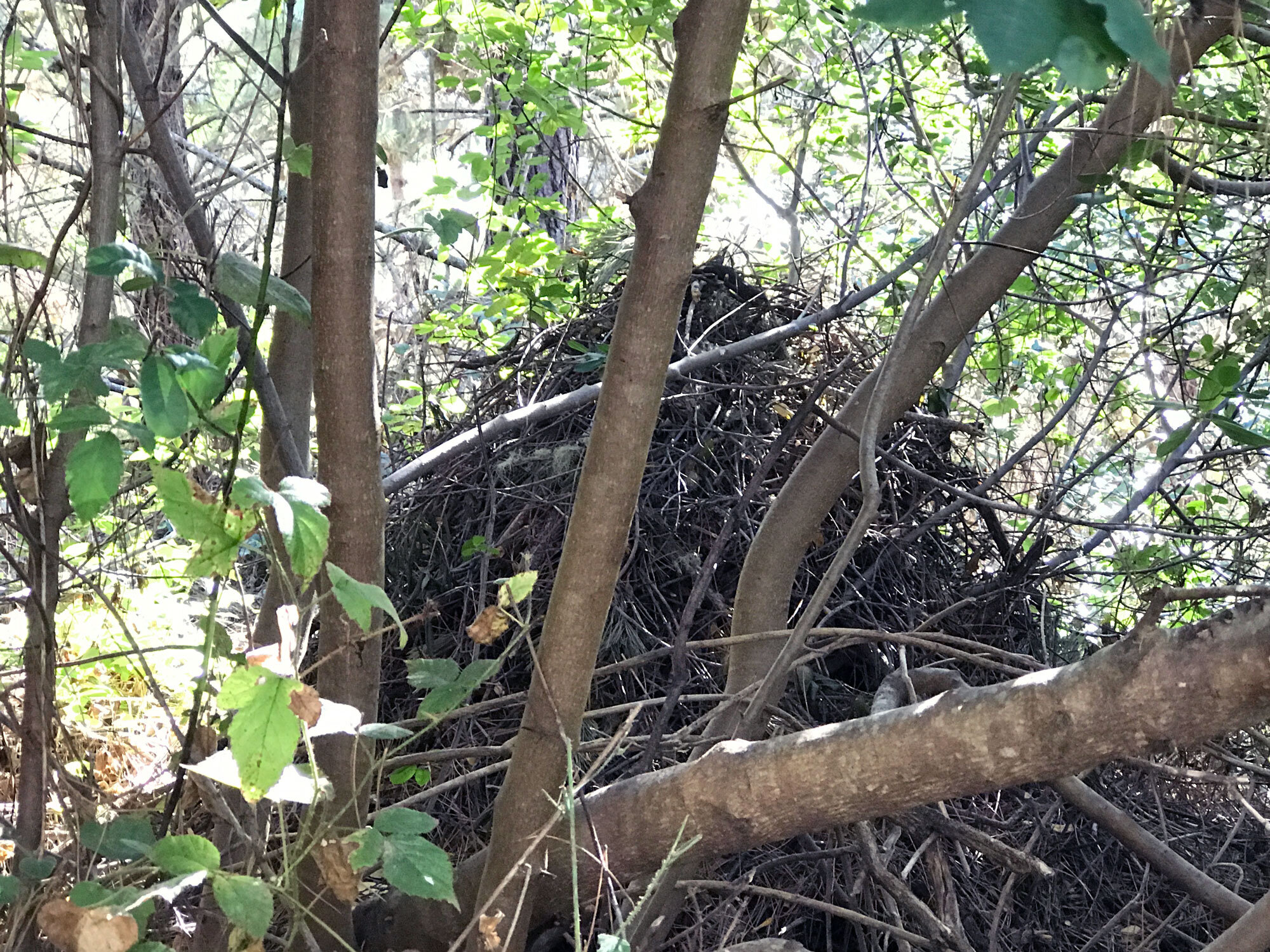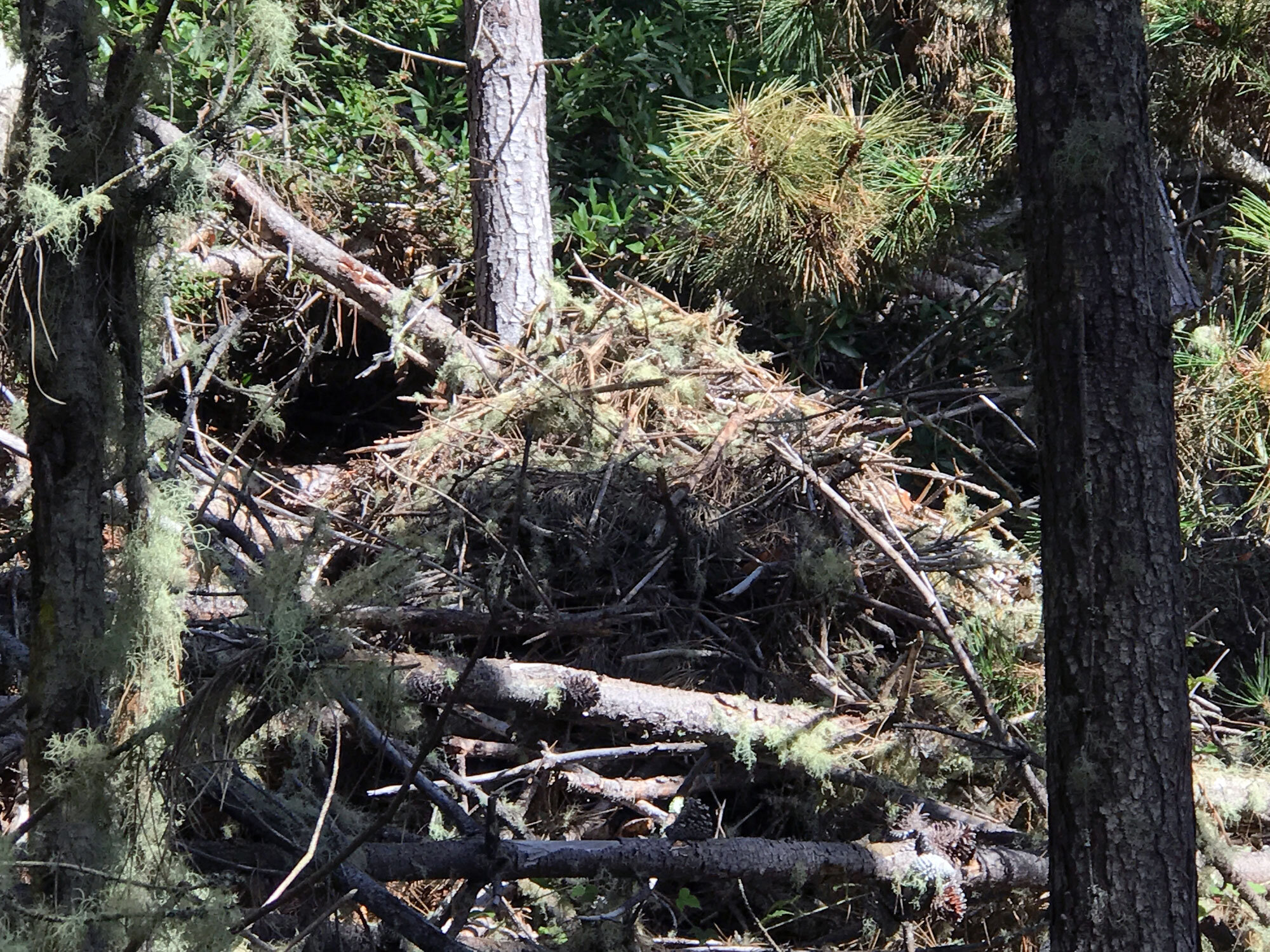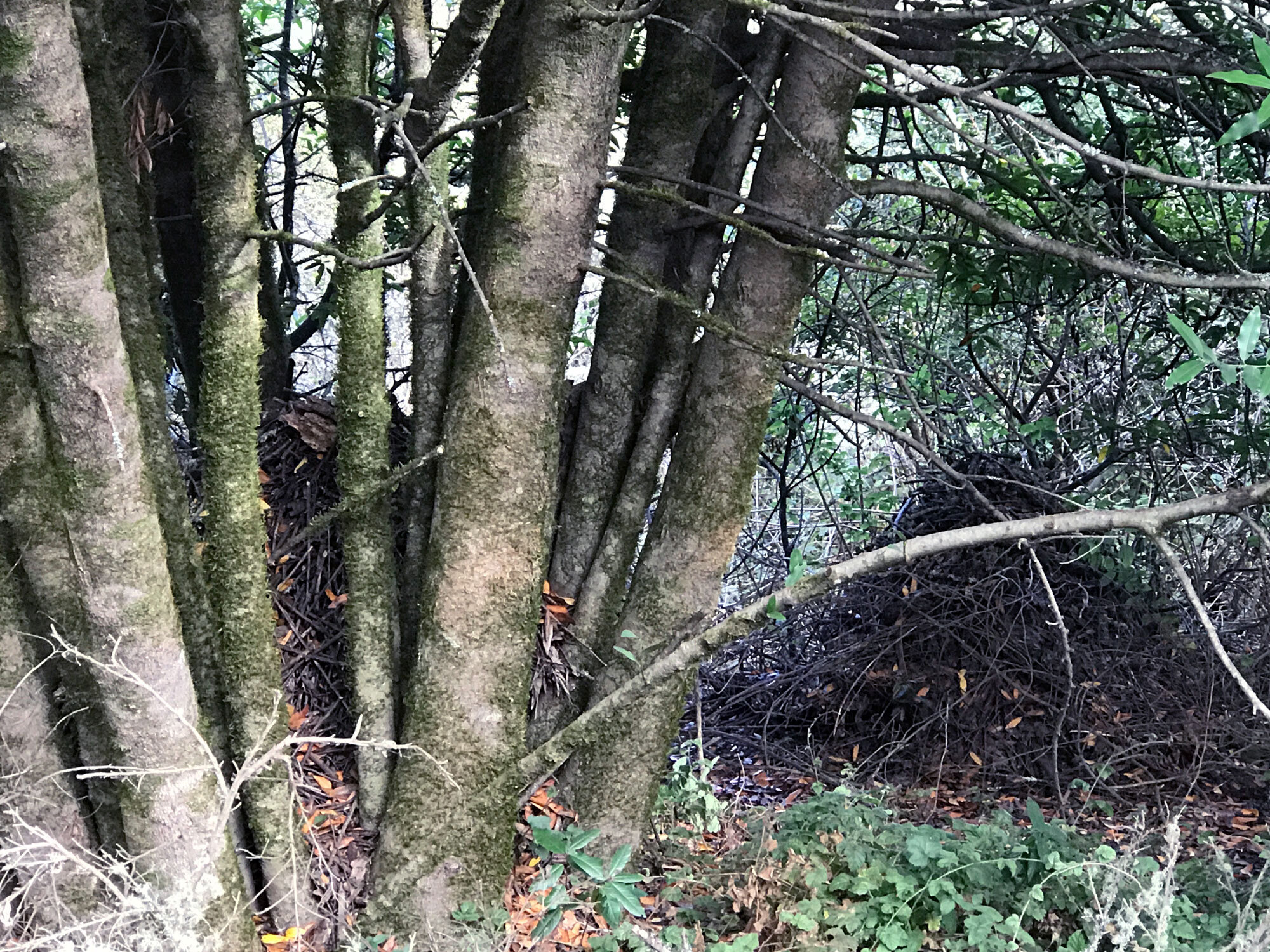Dusky-footed Woodrat
On a recent hike in barren November with few plants or insects to observe, I turned my attention to spotting Dusky-footed Woodrat (Neotoma fuscipes) nests. I knew from past hikes that the Bayview Trail was full of woodrat nests. My 5-mile loop route began at the Inverness Ridge Trailhead. I hiked the Inverness Ridge Trail to the Drakes View Trail and back to the trailhead via the Bayview Trail. I observed 54 nests using iNaturalist, but in fact, I saw many more that were either too far away or too difficult to photograph. On several occasions, I weaved through branches and brambles snagging my clothes and hair to admire the construction details of a nest up close while secretly hoping that I might spot a woodrat. No luck. I have never spotted a woodrat which is disappointing but understandable since they are nocturnal rodents and I hike during the daytime.
Dusky-footed woodrats are small with grey or brown backs, white undersides, and grey feet. They have long whiskers, rounded ears, and furry tails. The furred tail helps to distinguish them from non-native black rats. The name “dusky-footed” refers to their dark-colored feet. Dusky-footed woodrats are large rodents ranging from 10 to 19 inches, and average about 16 inches in length. This measurement includes their long tails, which account for nearly half their body length. Their bodies are typically 6 or 7 inches long.
They are similar in appearance to the common rat species Rattus rattus and Rattus norvegicus, but with larger ears and eyes, softer coats, and furred tails. Simply put, they are cuter.
It’s amazing how such small animals can build such towering nests, ranging from two to five feet tall and up to eight feet in diameter. I wonder how long it takes to stack layer after layer of sticks to these dimensions? The cone- or dome-shaped nests are insulated and adorned with pine needles, bark, bay leaves, lichen, and other plant materials. I can tell when a nest is recently occupied if it has fresh greenery on top, often sprigs of bay leaves.
A clue that you are near a nest or community is when you see narrow trails on the ground leading to the nest or between nests. I’m not sure if the trails are made from dragging materials over the ground to build the nests or if they are the beaten paths taken repeatedly by woodrats for their nightly foraging.
Woodrats are known to decorate their nests with objects they find, especially shiny objects. Sometimes, while carrying an item back to its nest, a woodrat will find another item and "trade" the one it is carrying for the new object. This habit has earned them the name "trade rat."
Drakes View Trail nests
Dusky-footed woodrats are solitary but their nests are often found in community clusters. When I spot a nest, I look in the surrounding area for a second nest. Pairs of nests are frequently within 20 feet of each other, and sometimes one is in the branches of a tree and another at the base of the tree. It’s not unusual for nests to be exposed near a trail. A single nest can house successive generations of woodrats, with offspring adding to nests making them larger. These nests may last for up to 60 years! The nests have elaborate tunnel systems inside, including elevated "terraces" on the outside where tunnels come out. The nests can have many chambers used for food storage, resting, nurseries, and protection. The sheer volume of stacked materials dissuades predators. Woodrats share their houses with other animals, including mice, lizards, salamanders, snails, the occasional snake, and parasites such as ticks, mites and fleas. In California, woodrats place nibbled-on California bay leaves (Umbellularia) around the edges of their nest to control fleas, ticks and mites. The leaves contain volatile organic compounds which are toxic to flea larvae. Abandoned nests provide habitat for a number of species.
Dusky-footed woodrats live in a matriarchal social system where females choose mates. After mating, males retreat to tree nests constructed in cavities or branches. Females stay in their terrestrial homes to raise one to four offspring. The daughters of female woodrats usually build or take over nests near their mothers’, creating maternal neighborhoods of extended, multigenerational families. Some mothers “bequeath” their own nests to a son or daughter, then go to live in a second home nearby.
Their exact lifespan is unknown, but other members of the genus typically live fewer than two to three years.
Bayview Trail nests
Dusky-footed woodrats are endemic to California and Western Oregon. They are found along the Pacific coast, west of the deserts and Great Basin. Forests of coast live oak and native willow trees with thick underbrush and cover are the ideal homes for dusky-footed woodrats. They build their nests around logs or near trees in areas that are shaded and cool.
Dusky-footed woodrats are chiefly herbivorous; they eat a variety of cuttings from branches, leaves, fruits, and nuts. They eat fungi and many kinds of plant materials, including seeds, greens, and inner bark. Woodrats store food cuttings in their nests; with nests averaging 4.5 species of herbivorous vegetation, though they tend to have a dominant food source making up the majority of cuttings, oak (Quercus) is preferred if available. Studies have shown that they feed on 72 different plant species, including acorns from various oak species. They often bring food back to their nest and eat it while inside.
Predators of woodrats include owls, hawks, coyotes, bobcats, foxes, weasels, skunks, snakes, and cats. Woodrats' main defense strategy is staying under cover, hidden from predators. Woodrats use their tails as a warning sign to predators. A male woodrat also uses its tail to indicate he wants to fight with another male. The woodrat beats his tail on the ground while opening and closing his mouth. In Point Reyes, they are a favorite prey of the Northern spotted owl (Strix occidentalis caurina). The abundance of woodrats likely accounts for the success of this threatened spotted owl species in Point Reyes.
See my Dusky-footed woodrat observations on iNaturalist.
Sources:
Woodrats: A home for the holidays (blog post with video by Matt Dolkas, Peninsula Open Space Trust)
The Skunk Corner, an online guide to your wild neighbors: Dusky-footed Woodrat


